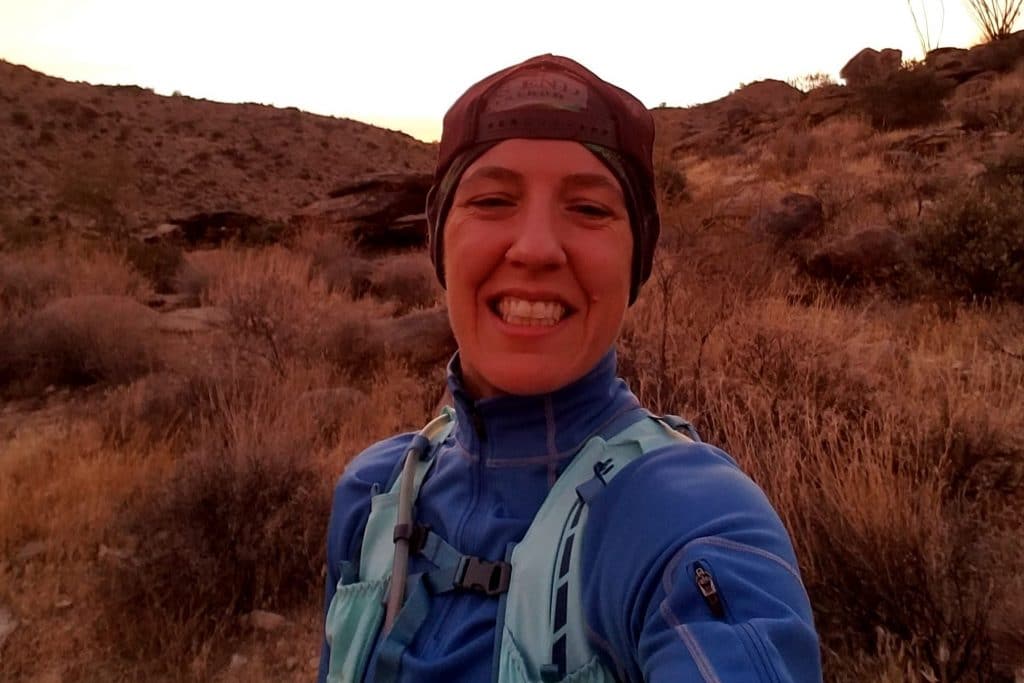Main Menu
Dark Side of the Run

Des is a plant-powered trail and ultra runner who grew up exploring the woods of central PA, and currently lives, runs and coaches in Arizona. She became a dual-sport athlete late in life, picking up rugby at the age of 43. She loves both of her sports for their community, and the way they allow her to express herself physically in a way that positively impacts the rest of her life.
Share This Article!


By: Deserae Clarke
I love running in the dark. This love has further blossomed now that I live in the southwest, and dark running is no longer synonymous with short, freezing, winter days. There’s something about moving through wild spaces enveloped in my little bubble of light that makes me feel even more connected to nature. It’s almost like I can sense the world around me that I can’t see. Also, there tends to be fewer people on the trails, meaning less distractions from the run and my surroundings.

As much as I love running in the dark, I know for some it can be intimidating. However, it is almost inevitable that at some point you’ll need to run in the dark, whether it’s because you’re running a long race, or your fitting training around a hectic schedule. So, I’m going to share some thoughts on how to make your transition to the dark side as enjoyable, and safe as possible.

When transitioning to running in the dark, much like transitioning from roads to trails, your pacing is going to change. Darkness tends to give the illusion that you are traveling faster than you are. Plus, you need to learn to navigate the trails in a whole new light, and there is extra mental energy that goes into judging the terrain and watching for turns. The good news is, just as with daytime trail running, the more time you spend doing it, the more natural it becomes, and the faster you’ll be able to travel.
Again, just as with trail vs. road running, there are added safety considerations with night running. First and foremost is the elevated chance that you will bite it while running at night. You can’t see as well, and things look different, so it will take your brain longer to get used to identifying hazards. You can reduce this risk by running on familiar trails, or smoother trails, as you adjust to night running. Also, there are different critters running around at night, so make sure you know what those critters are. I’ve met up with skunks, raccoons, coyotes, rattlesnakes, scorpions and foxes in the wee hours. However, none of these encounters had any negative outcomes (not that the possibility isn’t there). As with critters in the daylight, these wanted to be away from me as much as I wanted to be away from them – and I REALLY wanted to be away from that skunk. Make sure to stay alert and watch for animals to avoid startling them into a confrontation. As with any runs, carrying a communication device and letting people know where you are and when you plan to be back increases your safety on dark trail runs.
One way to help both with pacing and safety at night is to make sure you have appropriate lighting. The first consideration is lumens. I find my 300 lumen headlamp works just fine, although I’ve seen relatively lightweight headlamps claiming 1,000+ lumens. The advantage to a headlamp is that you automatically have light wherever you are looking. One drawback is that they can “wash out” the trail, making it look flat and harder to pick out stones and roots. Also, some people find headlamps to be uncomfortable, especially over time. There are alternatives including flashlights, knuckle lights, waist lights and shoe lights. You may even want to use a combination, for example a headlamp for general lighting and a flashlight to pick out trail hazards.
So now you’re aware of pacing challenges, safety considerations, and the need for a good light, but you’re still apprehensive about your first night run. What can you do to overcome those trepidations and get out after dark?

First, you can start by running in the dark just before dawn. It can be reassuring to know that you’re heading out in the dark, but that the sun is on its way. Music can help boost your confidence, I find the Wonder Woman theme song particularly effective. Just make sure the volume is low enough that you are still aware of your surroundings, especially since your sense of sight is also diminished. Maybe you can recruit some like minded friends to join you on your dark adventures, which will also help to alert critters to your location, and means you have someone to help pick you up and dust you off should you happen to bite it.
Races also provide a group setting for exploring the night. I personally used a local 12 hour overnight event to help prep me for the night running I knew was coming as part of my first 100 miler. Finally, and perhaps most importantly, embrace the adventurousness of a night run. You’re experiencing nature in a whole new way. Plus, I’ve gotten to see some pretty cool things through running at night. From sunrises and sunsets to owls and wild burros (a whole herd of them!) that I might have missed had I limited my running to daylight hours.
So, get some good lighting, get pumped up, and get ready to enjoy the trails in a whole new light.
Editors Note: For additional motivation to get out the door for dark runs, read our Ask the Trail Sisters: Motivation to Run in the Dark.
About the Author

Des is a plant-powered trail and ultra runner who grew up exploring the woods of central PA, and currently lives, runs and coaches in Arizona. She became a dual-sport athlete late in life, picking up rugby at the age of 43. She loves both of her sports for their community, and the way they allow her to express herself physically in a way that positively impacts the rest of her life.
Share This Article!











